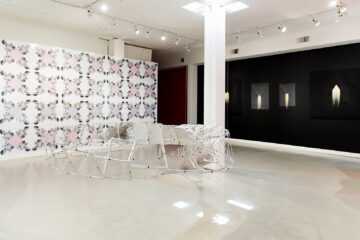Newest exhibit features work by artist Farheen HaQ that explores intergenerational relations, the past, the future and the concept of legacy
میں اپنی ماں کی بیٹی ہوں | I am my mother’s daughter is a solo exhibition hosted at the Campbell River art Gallery, featuring the works of acclaimed Canadian artist Farheen HaQ. The exhibition celebrates the resilience and knowledge systems of HaQ’s mother who arrived in Canada in the 1970s to meet her partner in an arranged marriage, settling in the Niagara region (Ontario), Haudenosaunee Territory. This body of work, presented on Kwakwaka’wakw Territory and in relation to the Salish Sea, comprises the artist’s meditations on themes such as caregiving, intergenerational pain, resilience and forgiveness.
The exhibition is a mixture of video, sculptural and installation art, which weaves together intergenerational relationships, connecting the experience of the artist’s mother with HaQ’s experience as a child of that union and subsequently, its impact on her own experience as a mother. The artist’s work of inner housekeeping includes personal journeys through a family’s past as a way of moving forward, and political reconciliations determined by the territories on which she and her family arrived as guests.
The exhibition is curated by Campbell River Art Gallery’s Curator of Contemporary Art Jenelle Pasiechnik and Haema Sivanesan, author and acclaimed Curator of South Asian Contemporary Art. This marks an important milestone as this is the first exhibition to tour out of the CRAG. The next destination for this exhibition is to the partner gallery, the Art Gallery of Hamilton in 2023; a journey back to Haudenosaunee Territory where HaQ’s mother immigrated to. The exhibition will continue onto The Reach Gallery and Museum on S’olh Temexw in 2024.
میں اپنی ماں کی بیٹی ہوں | I am my mother’s daughter is an extremely personal work, but HaQ hopes that all audiences will be able to connect to her story.
“My aspiration is for the viewer to have an experience with the work so that they reflect on their own personhood, their relationships, experiences and memories. I want the viewer to experience their humanity, their relationality – not just mine as the subject of the work — but their state of interiority.” – Farheen HaQ
The Exhibition is set to open on Sept. 1, with an opening reception at 5 pm in the gallery. The CRAG has many events and activities planned to accompany the exhibition, including a performance by Farheen and their Sunday Screening program.
Come see میں اپنی ماں کی بیٹی ہوں | I am my mother’s daughter in person at the CRAG on Thursday- Saturday 10 – 5 from Sept. 1 to Nov. 19.
About the Artist
Farheen HaQ: is a South Asian Muslim Canadian artist who has been living on unceded Lekwungen territory (Victoria, BC) for 20 years. She was born and raised on Haudenosanee territory (Niagara region, Ontario) amongst a tight-knit Muslim community. Her multidisciplinary practice which often employs video, installation and performance is informed by interiority, relationality, family work, embodiment, ritual and spiritual practice. Farheen’s current work focuses on understanding her family history on Canadian territories, caregiving and the body as a continuum of culture and time.
















